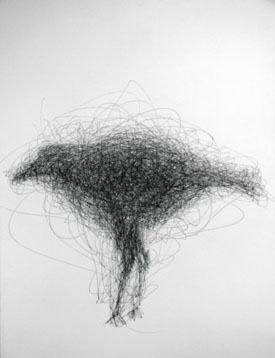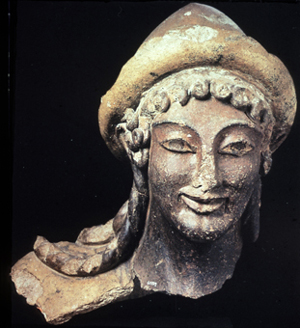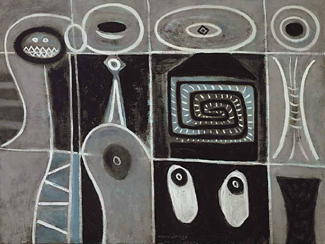| In This Issue |
 |
|
Welcome by Tom Singer
An Introduction to the ARAS Library on Art by Mary Wells Barron
The Myth of the Messenger by Jules Cashford
Labyrinth of the Shadow: History and Alchemy in Adolph Gottlieb’s The Prisoners by Michael J. Landauer and Bruce Barnes
Become a Member of ARAS Online!
Calendar of ARAS-Related Events
Explore Archetypal Images Weekly on Facebook
We Value Your Ideas
Receive This Newsletter for Free
|
Welcome |
 |
|
 In this edition of ARAS Connections, I want to highlight two ways in which ARAS Online is reaching out to our subscribers whom we are inviting to make substantial contributions of information and knowledge. In this edition of ARAS Connections, I want to highlight two ways in which ARAS Online is reaching out to our subscribers whom we are inviting to make substantial contributions of information and knowledge.
1. Contribute recommendations for articles in our new "ARAS Library on Art":
We need you to lend us your experience and knowledge. Over the past few years as we have been developing ARAS Online, it has become increasingly clear that one of the greatest potentials of this site is the opportunity to develop a uniquely focused electronic repository of the best articles on Art that focus on image, symbol, archetype, culture and complex. We have decided to call the new project the "ARAS Library on Art". We are inaugurating the naming of this project with a fine essay by Jules Cashford.
What we want from you is your list of the most significant and influential articles that you have read which focus on image, symbol, archetype, culture and complex. For each article that you suggest, please include the title of the article, the name(s) of the author(s), the publication and date in which it appeared. We can not guarantee that we will include every suggestion in our new room as there are copyright, permission and suitability issues that need to be processed. Help us make our "ARAS Library on Art" a rich and unique resource for the world. Please send your submissions to info@aras.org.
2. Spread the word and contribute to our ARAS Image/Cultural Complex Research Project
This is an absolutely unique research project that offers professors, students, artists and anyone interested in the relationship between image, symbol and complex a chance to contribute. See letter of invitation. It is ideal for university courses to include as an independent research project in fields as varied as psychology, art history, anthropology, history and other cultural studies. Please send your submissions to info@aras.org.
Tom Singer, M.D.
Co-Chair of ARAS Online for National ARAS

|
Become a Member of ARAS Online! |
 |
Become a member of ARAS Online for just $100 ($25 for certain students and candidates) each year, which is tax-deductible. You'll receive free, unlimited use of the entire archive of 17,000 images and 20,000 pages of commentary any time you wish—at home, in your office, or wherever you take your computer.
The entire contents of two magnificent ARAS books: An Encyclopedia of Archetypal Symbolism and The Body are included in the archive. These books cost $300 when purchased on their own.
You can join ARAS Online instantly and search the archive immediately. If you have questions, please call (646) 536-2632 or email info@aras.org. |
Calendar of ARAS-Related Events |
 |
|
In Los Angeles:
October 22, 2011: Rock Art Research and Jungian Psychology. Presented by John Ranyard, M.A.
In San Francisco:
October 29, 2011: Initiation in Ancient Greece and Modern Psyche: A Workshop with Virginia Beane Rutter and Thomas Singer
In New York:
October 1, 2011: Jung and the American Psyche: A Symposium For the 50th anniversary of the death of C.G. Jung
|
Explore Archetypal Images each Week |
 |
|
ARAS is now on Facebook! Become a fan by clicking here to join our community and stay updated. We post the latest news on ARAS publications and projects and weekly explorations of symbols and archetypes accompanied by images from ARAS! If you don't have a Facebook account, you can set one up here.
We look forward to connecting with you! |
We Value Your Ideas |
 |
|
As our newsletter grows to cover both the ARAS archive and the broad world of art and psyche, we're eager to have your suggestions and thoughts on how to improve it. Please click here to email us or send your comments to info@aras.org. We look forward to your input and will reply to every message.
|
Receive This Newsletter for Free |
 |
| If you're not already a subscriber and would like to receive subsequent issues of this newsletter by email at no cost, click here or e-mail us at newsletter@aras.org. Please invite friends and colleagues who may be interested to join as well. Thanks! |
|
 |
| An Introduction to The ARAS Library on Art |
 |
by Mary Wells Barron

A Bird by Bert Kupferman, 2008. |
I am pleased to introduce our new room, ARAS Library on Art. My Associate Editor is Ami Ronnberg. This room is dedicated to the collection of some of the very finest articles on art viewed from the depths of psyche and the breath of imagination.
"The great danger of a psychological approach to a work of art is that it may kill the poetry, in which case such an undertaking is worse than meaningless."
(Dark Wood to White Rose: Journey and Transformation in Dante’s Divine Comedy by Helen Luke)
With the words of Helen Luke in mind, we are gathering articles published and unpublished which explore art with the soul’s eye.
We hope this room will be a place of pleasure and research. It will contain articles on contemporary artists, as well as earlier époques and cultures.
It is an honor and a delight to offer Jules Cashford’s The Myth of the Messenger as the first work to land on the shelves of the library. This article of astonishing beauty is a particularly appropriate one with which to inaugurate the collection for it speaks of and through the archetypal images behind the library itself. The Messenger, linking together word and image, wings his way through the digital realm.
Jules opens her work with the image of an Etruscan Hermes and the words "a smiling knowledge of eternity." This is only the first of many moments, as you read, that will cause you to gasp at the presence of the god in the art of her pen. This opening describes, not only the image of Hermes, but the very essence of her article for she writes with a mind of vast erudition and a heart permeable in the extreme to the vision beyond.
|
| The Myth of the Messenger |
 |
by Jules Cashford

The Etruscan Hermes. Terracotta statue, c. 500 B.C. |
The German novelist Thomas Mann, in his address on the occasion of Freud’s 80th birthday, spoke of myth as offering a "smiling knowledge of eternity" – such, perhaps, as is evoked by this Etruscan Hermes of 500 BC (1936, p. 89)
It is impossible to define Imagination since the only definition we can make is that we are far from it when we talk about it. It is perhaps a power so ultimate that only its own numinous images can call it forth, as though we have, as it were, to ask the Imagination to imagine itself. We might say that whenever there is numinosity – a coming alive of divine presence – literally, the "nod" or "beckoning" of a god – whenever an image becomes translucent to a reality beyond itself, we are in the presence of Imagination. The images that come towards us – as divinities, daimons, soul-birds, angels, geniuses, muses – are all figures who bring messages from afar or beyond, from the heights or the depths – the realms where consciousness may not go, yet on which it rests and through which it grows. "Wisdom first speaks in images," W. B. Yeats, says (1961, p. 95).
The role of "the messenger" is to go between, and so to connect, two terms – gods or persons or worlds or states of being. The need for a messenger implies that the message cannot be carried directly, because the two terms belong to different orders of reality. These different orders have been variously named: divine and human, heaven and earth, the night world and the day world, dreaming and waking life, the world of faery and the world of men, the sacred and the profane, eternity and time – or, more simply, the unconscious and the conscious.
The messenger has something of both realms, and so can move between one world and another as the intermediary who explores their permeability to each other and seeks out a common purpose. So the myth of the messenger is primarily a myth of relationship, where two dimensions of being are brought into relation with each other and are united in a new whole. The caduceus which so many of these figures carry with them – two snakes uniting around a central staff – expresses the essence of this myth as a new synthesis of hitherto antithetical modes of being.
Mythic images of messengers appear throughout history in most, if not all, cultures, and they all bear a family resemblance to each other, suggesting an archetypal image belonging to the structure of the psyche, one which the psyche needs for its wholeness. So the outer myths mirror and explore the inner psychic drama, telling stories of imagination in all its unmanageable diversity. As with other mythic images, there is both a universal theme and an ethnic, local inflection. The original experience common to all of them would seem to be the magic of the bird.
Read The Myth of the Messenger by Jules Cashford in its entirety.
 |
Labyrinth of the Shadow: History and Alchemy in Adolph Gottlieb’s The Prisoners |
 |
by Michael J. Landauer and Bruce Barnes

The Prisoners by Adolph Gottlieb, 1947. |
The papers of Michael J. Landauer and Bruce Barnes were presented at the Art and Psyche Conference in San Francisco in 2008. Their fine presentations were enhanced by the exceptional generosity of Michael Landauer in arranging for The Prisoners to be shipped to San Francisco as part of the conference where it was graciously exhibited at the Stephen Wirtz Gallery.
- Tom Singer
PART 1 - The Prisoners by Adolph Gottlieb: A Systematic Symbolic Interpretation
by Michael J. Landauer
I first met this painting at the Waddington-Shiell Gallery in Toronto in 1979. Miriam Shiell had brought The Prisoners over for the season's opening show from Leslie Waddington's London Gallery. The Prisoners dominated its space and bowled me over with its larger than life presence. It brooded gloom, spat menace, radiated stubborn hope. I fell in love immediately.
In 1945 Gottlieb wrote in the New York Times, "Painting is the making of images. All painters strive for the image but some produce only effigies. This outcome is not determined by the degree of resemblance to natural objects; rather it is by the invention of symbols transcending resemblance that imagery is made possible. If the painter's conception is realized in the form of an image, we are confronted with a new natural object which has its own life, its own beauty and its own wisdom."
At about the same time, speaking rhetorically about his own art, Gottlieb said "If the origin of painting was the making of marks or poetic signs should we consider the painter an artisan-poet or is he the artisan-architect of a formal structure? Or both?"
Gottlieb and Mark Rothko with Barnett Newman’s assistance drafted a letter to Alden Jewell Art Editor at the NYT on June 7, 1943. They said, "No possible set of notes can explain our paintings. Their explanation must come out of a consummated experience between picture and onlooker. The appreciation of art is a true marriage of minds." I have been engaged for almost thirty years with this beguiling work, to consummate my experience with it.
When I embarked on the quest for a systematic symbolic interpretation of The Prisoners in the early 1980s most art historians were of the view that the proper subject matter of the abstract expressionist painter was the artist's psyche itself, and the more subjective aspects of the psyche at that. The highest and most advanced painting portrayed exalted feeling, which the artist expressed in pure form and color. The paintings did not refer to history, let alone with narrative structure.
In 1988 Stephen Polcari published an article called "Adolph Gottlieb's Allegorical Epics of World War II". Polcari identified the pictographs as responses by Gottlieb to the crisis of western civilization he experienced around him in the Great Depression and the World War. He analyzed the modern intellectual currents Gottlieb utilized in exploring the crisis including evolutionary theory, cultural theory, mythology, symbolist literature, Jungian concepts and alchemy. Since Polcari wrote, it has become increasingly respectable to inquire into the social meanings that artists thought to embody in their work.
The Prisoners is unique in the pictograph series in three ways. Gottlieb painted one version of The Prisoners in 1946 and then a second in 1947. Sanford Hirsch, founding Director of the Adolph and Esther Gottlieb Foundation, states that this was the only time that Adolph Gottlieb returned to a finished pictograph in order to repaint it. The Prisoners is also unique, according to Hirsch, as the most explicit response by the artist to the horrors of World War II. Finally in my view The Prisoners is unique in that the symbolic structure of this work lends itself readily to a systematic interpretation. Whereas most pictographs, composed by free association, do not possess a clear narrative structure, The Prisoners, in my view of it, does. The Prisoners can be interpreted as a sweeping allegory of the development and polarities of the human psyche in society. Adolph Gottlieb has created an epic painting of ideas, expressed in dense, layered, abstract symbols connected syntactically through the organization of Gottlieb's characteristic pictograph grid.
Read the entire paper.
 |
|

